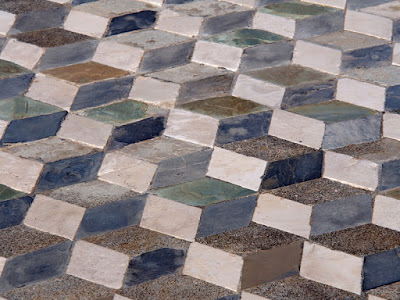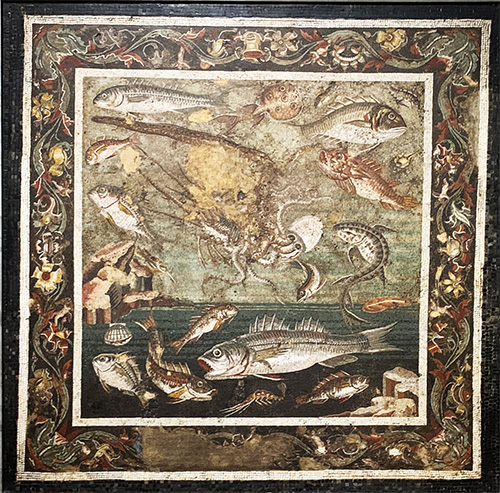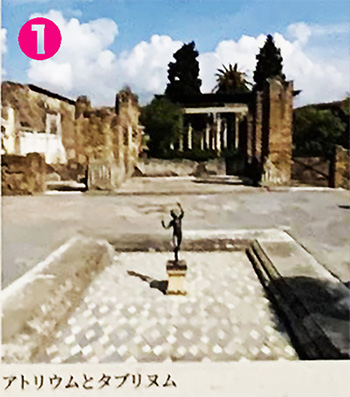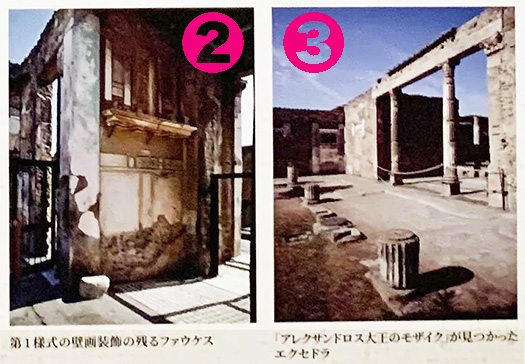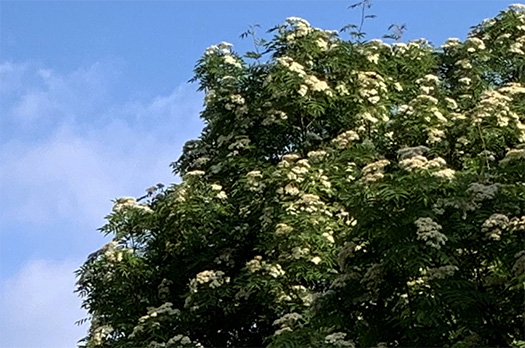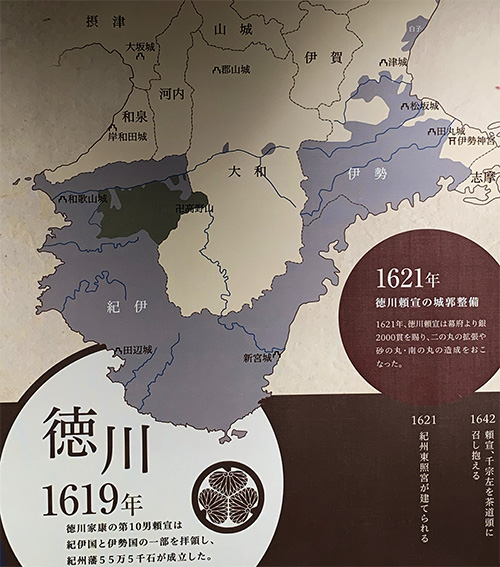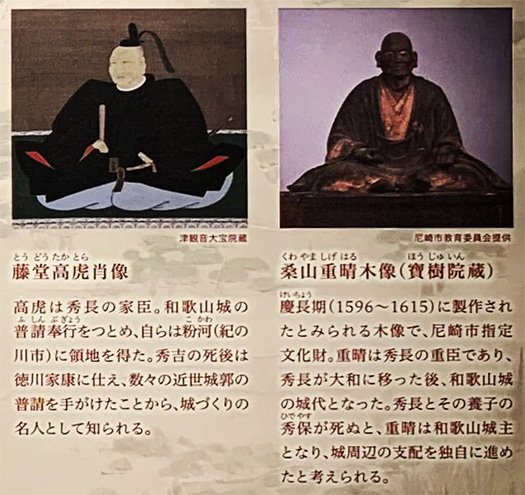

ポンペイ遺跡でももっとも保存状態が良かったとされる家。
2200年前に建てられた家だけれど、1960年前のAD62年には地震被害があって
その時点でリフォームされ通りに面した側が店舗になったという。
裏手側は「洗濯屋」になってその時点で2階建てに改造されたという。
そういった事実痕跡までが発掘可能だったということにも
驚かされるけれど、こういった復元の様子などを見ると
古代に於いてこの地中海地域はヨーロッパ文明のコアであり、
そこでかれらの「暮らし方」はその基底のカタチができていたと考えられる。
人口1万人という集住都市での普遍的な暮らし方・ライフスタイル。
「洗濯屋」という具体的な職業名からはいろいろな社会状況が類推される。
近郊農村地域から出稼ぎ的な次男三男層がポンペイに来て職に就いていて
かれらの日常生活上欠かせないサービス業として成立したか。
また、店舗になったというのは「不動産市場」というものの登場を暗示する。
集住と人間交通という商業活動の基盤が明瞭に存在したのだろう。
農業という基本的生産手段が確立していくと同時に
人類社会では余剰人口が生み出され、より生存しやすい都市集住が始まった。

このモザイクは玄関の床面に刻印されたもので「猛犬注意」と書かれている。
よくみると鎖で繋がれている様子も描かれている。
イヌを泥棒などからの防衛手段として使役する習慣がわかる。
集住都市生活では「治安維持」という必要性は了解可能。
この家からはたくさんのモザイクが発見されているけれど
それらの多くは古代神話に取材したテーマが描かれているとされる。
ファウヌスの家でも「アレクサンドル大王の征戦」モザイクがあったけれど、
自分たち社会の「正統性」についてのアイデンティティ・証明と受け取れる。
あるいは「歴史」という概念がかなり具体的に追究されたのかも知れない。
そういう意味では社会のなかでの「有力者」というのは、
なぜ自らがその立場、位置にあるかについて他者に証すものを求めた。
モザイクという表現手段はもっとも初源的インパクトを与える「画像」で
そういう視覚的伝達として機能させたのではないか。
そのように考えると一種のテレビのような「メディア」と捉えられる。
そういうメディアが壁は言うに及ばず、床面にも描かれたのは、
やはりモザイクという独特の表現手法にその根拠があったように思える。
たくさんの色合いの自然石ピースをモルタル素材で「固めて」
展着させて行くには壁面では相当に困難が伴い、
より安定的な展示形式として床面展示が選択された可能性が高い。
また描かれるテーマがより複雑になっていって
専用の「製作工房」で仕上げられ、大型のものになると
壁面では展着が難しくなっていった経緯があるように思える。
ヨーロッパ文明と暮らし方の初源が垣間見えて興味深い。
English version⬇
The first source of European urban agglomeration Pompeii, House of the Tragic Poet-2
Traces of commercial conversion renovation in urban agglomeration and “real estate value”. Mosaic painting as a communication image media. …
The house is said to be the best preserved of the Pompeii ruins.
Although the house was built 2,200 years ago, it was damaged by an earthquake in AD 62, 1960.
At that time, the side facing the street was remodeled and turned into a store.
The back side of the house was converted to a laundry and then to a two-story building.
It is amazing that such traces of fact could even be excavated.
I am surprised that such traces were excavated, but when I look at the restoration of the building, I am amazed at how it was restored.
The Mediterranean region was the core of European civilization in ancient times, and their “way of life” there was the same as that of the rest of Europe.
The way of life in the Mediterranean region is considered to be the core of European civilization in ancient times, and their “way of life” is thought to have taken its basic form there.
A universal way of life and lifestyle in a city with a population of 10,000.
The specific occupational name “laundress” suggests a variety of social conditions.
The second and third sons of the population who migrated from nearby rural areas came to Pohnpei to work, and they were employed as laundresses.
Was it established as a service industry indispensable to their daily lives?
The fact that it became a store also implies the emergence of a “real estate market.
The basis for commercial activities, such as housing and human transportation, must have clearly existed.
At the same time that the basic means of production, agriculture, was being established
At the same time that the basic means of production, agriculture, was established, a surplus population was created in human society, and urban settlements began to be established to make it easier to survive.
This mosaic is engraved on the floor of an entrance hallway and reads “Beware of Raging Dogs.
If you look closely, you can see a dog on a leash.
This shows the custom of using dogs as a means of defense against thieves and other threats.
The need to “maintain security” is understandable in the urban lifestyle.
Many mosaics have been found in this house.
Many of them are said to depict themes based on ancient mythology.
In the House of the Fauns, there is a mosaic of the “Conquest of Alexander the Great.
It can be taken as an identity proof about the “legitimacy” of their society.
Or perhaps the concept of “history” was pursued in a very concrete way.
In this sense, the “influential people” in a society are not necessarily the same as those who are in power.
In this sense, “influential people” in society sought proof from others as to why they were in the position they were in.
The mosaic is a means of expression, an “image” that has the most primordial impact.
It may have functioned as such visual communication.
In this way, it can be seen as a kind of “media” like television.
The fact that such media were drawn not only on the walls but also on the floor
The reason why such media were painted not only on the walls but also on the floor seems to have its basis in the unique expression technique of mosaic.
The use of mortar material to “harden” and adhere the natural stone pieces of various shades of color to the surface of the wall is a unique method of expression.
The wall surface was quite difficult to “harden” and adhere to, and the floor was chosen as a more stable exhibition format.
It is highly possible that the floor was chosen as a more stable exhibition format.
The themes of the paintings became more and more complex.
and the more complex the subject matter, the more difficult it would have been to mount on the wall.
The larger the paintings became, the more difficult it became to display them on the wall.
It is an interesting glimpse into the origins of European civilization and way of life.
Posted on 5月 30th, 2022 by 三木 奎吾
Filed under: 住宅マーケティング, 歴史探訪 | No Comments »








